List of stumbling blocks in Berlin-Dahlem
The list of stumbling blocks in Berlin-Dahlem contains the stumbling blocks in the Berlin district of Dahlem in the Steglitz-Zehlendorf district, which remind of the fate of the people who were murdered, deported, expelled or driven to suicide under National Socialism. The columns in the table are self-explanatory. The table records a total of 24 stumbling blocks and is partially sortable; the basic sorting is done alphabetically according to the family name.
| image | Surname | Address and Coordinate ( |
Laying date | Life | |
|---|---|---|---|---|---|

|
Gustav Amigo | Bitterstrasse 3a | May 25, 2014 | Gustav Amigo was born on April 9, 1879 in Vienna, two of his grandparents were Jewish, the others were not. He became a precision mechanic and acquired optical knowledge. In 1906 he married the non-Jewish Marie Katharina Wilhelmine Hasenstab in Nuremberg, and they moved to Berlin. Her son Manfred was born there on September 19, 1908. Gustav Amigo went into business for himself with a vending machine shop on Ritterstrasse, around 1920 he developed a film camera for 38 mm film in a wooden case, later he switched to the production of loudspeakers. At the radio exhibition in 1926 he presented the Amigo-Horn funnel loudspeaker. His business moved to Fürstenstraße 3, privately he lived with his family on Brandenburgstraße (today Lobeckstraße), from 1933 in Dahlem in house Bitterstraße 3a, which he also owned. His son Manfred traded in car accessories and officially took over the business at the end of the 1930s, but Gustav Amigo came to the factory every day by train from Dahlem, hung his coat with the Jewish star in the closet and went about his projects. During the Second World War, the company, with around 20 employees, manufactured essential metal parts as a supplier for Siemens and Askania. Gustav Amigo was arrested in the summer of 1942, interned in the Wuhlheide labor education camp and shot on August 18, 1942. His widow and son emigrated to England. | |

|
Bruno Asch | Breisacher Strasse 19 | March 7, 2009 | Bruno Asch was born on July 23, 1890 in Wollstein , Posen Province ( Wolsztyn , Greater Poland Voivodeship ) to Jewish parents. After completing a commercial apprenticeship, he first worked in a textile factory. He took part in the First World War as a soldier from 1914 to 1918. After the war he became a member of the USPD. In 1923 he was elected mayor of Höchst am Main (today: Frankfurt-Höchst ). In 1931 he became a member of the Berlin city council. After the National Socialists came to power, he was first given leave and later dismissed. Together with his wife Margarete Asch and their three daughters, he emigrated to the Netherlands in autumn 1933. After the successful campaign in the west and the invasion of the Netherlands by German troops, he committed suicide on May 15, 1940. His wife and two of his daughters were deported to the Sobibor extermination camp. His third daughter emigrated to Palestine in 1939. | |

|
Leo Berlak | Habelschwerdter Allee 7 | Sep 15 2007 | Leo Berlak was born on January 22nd, 1864 in Posen as the first child of Hermann Berlak and his wife Milka, née Hirschfeld. His mother died when he was one year old, his father married Caecilie Caro, the half-siblings were born: Heinrich (1867), Albert (1869), Selma (1871) and Michael (1881). His father Hermann Berlak had a grain and potato trade in which Leo worked. Leo Berlak married Sophie Merzbach, the children were born in Posen: Milli in 1895 and Hermann Ludwig in 1896. In the early 1920s Leo Berlak lived in Berlin and worked for the company Hermann Berlak, Grains and Potatoes, founded by his father was entered in the commercial register, he was also involved in the company Polensky & Co.KG, potato and grain wholesale. In 1921 Leo Berlak lived with his wife and children in his own house at Werderstrasse 7, (today Habelschwerdter Allee). His wife died in 1936, his son emigrated to England, and after 1939 his daughter Milli too, and in 1938 both companies were liquidated. Leo Berlak had to move again to the house at Am Park 15 in Schöneberg. On October 3, 1942, he was deported from there to Theresienstadt, where he was murdered on April 14, 1943. The stumbling block for Leo Berlak had already disappeared a week after the laying, and the hole that had formed was paved . Those responsible for the crime could not be identified. A second stone was laid almost two years later on July 3, 2010. | |

|
Bernhard Single | Hittorfstrasse 16 | July 6, 2010 | Bernhard Einzig, born on November 12, 1874 in the Czech Republic , ran a clothing factory in Berlin . He had been married to Eugenie, nee Weishaus, since August 9, 1896. After the Dahlem domain had been divided up , the couple acquired the property at Hittorfstrasse 16 in the early 1920s and built a villa there. The couple went into hiding in the early 1940s and finally attempted to escape to Switzerland in July 1943 . When leaving the train in Singen , an identity card check was carried out, during which Bernhard Einzig was arrested. His wife, a friend and a smuggler escaped and reached Switzerland the following night. Bernhard Einsig was deported to the Theresienstadt concentration camp on August 4, 1943 on the 95th transport for the elderly . In December 1943 he was murdered. Eugenie Einzig survived the Holocaust and lived in England from 1947 after the war. She later returned to Germany, where she died in 1980. |
|

|
Curt Jakob Eisner | Bachstelzenweg 16 | location | 5th March 2016 | Curt Jakob Eisner was born on April 28, 1890 in Zabrze , Province of Upper Silesia (today: Zabrze , Voivodeship of Silesia ). In the 1920s he was director of Rawack & Grünfeld Eisenerz AG. From 1926 to 1928 he had a house built in Berlin-Dahlem by the architect Harry Rosenthal . He lived there with his wife Erna Eisner and their children Eva Eisner and Ruth Eisner. In 1936 the family flew to The Hague in the Netherlands. As part of the western campaign of the German Reich, the Netherlands was occupied in 1940; from 1942 the Eisner family was forced to hide in order to avoid deportation due to their Jewish origins. Until the end of the war they stayed with different people in the Netherlands. The entire family survived the Holocaust. Eisner died on December 30, 1981 in The Hague. |

|
Erna Eisner | Bachstelzenweg 16 | location | 5th March 2016 | Erna Eisner (nee Grünthal) was born on November 19, 1897 in Zabrze , Upper Silesia Province (today: Zabrze , Silesian Voivodeship ). She married Curt Jakob Eisner, who was the director of Rawack & Grünfeld Eisenerz AG. From 1926 to 1928 he had a house built for himself and his family by the architect Harry Rosenthal in Berlin-Dahlem. Erna Eisner lived there with her husband and their children Eva and Ruth Eisner. In 1936 the family flew to The Hague in the Netherlands. As part of the western campaign of the German Reich, the Netherlands was occupied in 1940; from 1942 the Eisner family was forced to hide in order to avoid deportation due to their Jewish origins. Until the end of the war they stayed with different people in the Netherlands. The entire family survived the Holocaust. Erna Eisner died on November 6, 1981 in The Hague. |
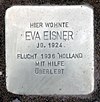
|
Eva Eisner | Bachstelzenweg 16 | location | 5th March 2016 | Eva Eisner was born on October 29, 1924. She was the daughter of company director Curt Jakob Eisner and his wife Erna Eisner. From 1926 to 1928 he had a house built for himself and his family by the architect Harry Rosenthal in Berlin-Dahlem. The family lived there until they had to flee to The Hague in the Netherlands in 1936. As part of the western campaign of the German Reich, the Netherlands was occupied in 1940; from 1942 the Eisner family was forced to hide in order to avoid deportation due to their Jewish origins. Until the end of the war they stayed with different people in the Netherlands. The entire family survived the Holocaust. Eva Eisner died in Amsterdam on November 24, 1965. |

|
Ruth Eisner | Bachstelzenweg 16 | location | 5th March 2016 | Ruth Eisner was born on June 10, 1920. She was the daughter of company director Curt Jakob Eisner and his wife Erna Eisner. From 1926 to 1928 he had a house built for himself and his family by the architect Harry Rosenthal in Berlin-Dahlem. The family lived there until they had to flee to The Hague in the Netherlands in 1936. As part of the western campaign of the German Reich, the Netherlands was occupied in 1940; from 1942 the Eisner family was forced to hide in order to avoid deportation due to their Jewish origins. Until the end of the war they stayed with different people in the Netherlands. The entire family survived the Holocaust. Ruth Eisner died on November 9th, 2009 in Loenen aan de Vecht . |

|
Gerhard Fuchs | Schweinfurthstrasse 90 | location | March 27, 2015 | Gerhard Fuchs came to Kreuzburg / Silesia on July 19, 1894 as the son of the doctor Dr. Ferdinand Fuchs and his wife Emilie born Zimmermann. His brothers were Erich (1897) and Hans (1899). Gerhard Fuchs became a graduate engineer and patent attorney. He married Käthe Hecht, their daughter Renate was born on March 27, 1923. The family lived first at Parkstrasse 6 in Dahlem (today Bernadottestrasse), later at Schweinfurthstrasse 90. Gerhard Fuchs' office was in Unter den Linden. In 1938 Gerhard Fuchs emigrated to Sweden with his wife and daughter. He died in Stockholm in 1961. |

|
Käthe Fuchs | Schweinfurthstrasse 90 | location | March 27, 2015 | Käthe Hecht was born in 1901 into a Jewish family, she married the graduate engineer and patent attorney Gerhard Fuchs. The daughter Renate was born on March 27, 1923. The family lived in Dahlem, first on Parkstrasse (today Bernadottestrasse) and later on Schweinfurthstrasse 90. In 1938, Käthe Fuchs emigrated to Sweden with her husband and daughter. She died in Stockholm. |
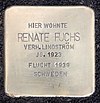
|
Renate Fuchs | Schweinfurthstrasse 90 | location | March 27, 2015 | Renate Fuchs was born on March 27, 1923 as the daughter of the graduate engineer and patent attorney Gerhard Fuchs and his wife Käthe nee Hecht. She emigrated to Sweden with her parents in 1938. |

|
Ludwig Fulda | Miquelstrasse 86 | Oct 29, 2010 | Ludwig Anton Salomon Fulda was born on September 15, 1862 in Frankfurt am Main . He committed suicide in Berlin on March 30, 1939, probably due to his imminent deportation.
|
|

|
Gertrud Goldmann | At the Hegewinkel 108 | July 6, 2010 | Hedwig Gertrud Laboschin was born on December 5, 1882 in Guben / Brandenburg as the daughter of Emil Laboschin and his wife Philippine, born Sklower. In 1910 she married the district judge Dr. Ernst Selmar Goldmann. They lived in Berlin at Witzlebenstrasse 3 III, and their daughter Hilde Elisabeth was born on February 26, 1917. Her husband, who had meanwhile become a member of the chamber judge, died around 1931. Gertrud Goldmann moved to Zehlendorf in her own house at 108 Hegewinkel. Her daughter Hilde emigrated to England and in 1938 married William Dennis Elcock. Gertrud Goldmann had to move to the house at Am Stadtpark 3 in Steglitz, from where she was deported to the Warsaw Ghetto on April 2, 1942, and murdered at an unknown date. | |

|
Edda Edith Hagelberg | Schwendenerstrasse 46 | May 25, 2014 | Edda Löwenthal was born on May 31, 1881 in Berlin as the daughter of the publisher Salo Löwenthal and his wife Guta Henriette née Löwenthal. In 1908 she married the lawyer Ernst Hagelberg, and she stated dissident under religion. The daughters were born: Lotte on June 26, 1909 and Rita Jutta on July 15, 1910. Ernst Hagelberg had his office on Charlottenstrasse, later on Friedrichstrasse and from 1930 on Joachimsthaler Strasse. The family lived privately in Dahlem, Humboldtstrasse 46 (today Schwendenerstrasse) since the 1920s. After the Nazis came to power, Ernst Hagelberg was able to work as a lawyer until 1936, after which this was prohibited. Her husband had to sell the house and the family moved to Kaiserdamm 72. The daughter Rita fled to England, Edda Hagelberg was deported with her husband Ernst and daughter Lotte to Riga on October 19, 1942 and there on October 22, 1942, the Day of her arrival, shot in the surrounding woods. | |
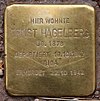
|
Ernst Hagelberg | Schwendenerstrasse 46 | May 25, 2014 | Ernst Anton Hagelberg was born on July 12, 1876 in Berlin as the son of the dentist Moses Max Hagelberg and his wife Clara Augusta nee Dewitz. He had a brother Emil. Ernst Hagelberg studied law at the University of Halle, received his doctorate and set up as a lawyer in Berlin. In 1908 he married Edda Löwenthal, the daughters were born: Lotte on June 26, 1909 and Rita Jutta on July 15, 1910. Ernst Hagelberg had his office on Charlottenstrasse, later on Friedrichstrasse and from 1930 on Joachimsthaler Strasse. The family lived privately in Dahlem, Humboldtstrasse 46 (today Schwendenerstrasse) since the 1920s. After the Nazis came to power, Ernst Hagelberg was able to work as a lawyer until 1936, after which this was prohibited. Ernst Hagelberg had to sell the house and move to Kaiserdamm 72 with his family. The daughter Rita fled to England, Ernst Hagelberg was deported with his wife Edda and daughter Lotte to Riga on October 19, 1942 and shot there in the surrounding woods on October 22, 1942, the day they arrived. | |

|
Lotte Hagelberg | Schwendenerstrasse 46 | May 25, 2014 | Lotte Hagelberg was born on June 26, 1909 in Berlin as the daughter of the lawyer Ernst Hagelberg and his wife Edda, born Löwenthal. She had a younger sister, Rita. In 1939 Lotte still lived with her parents in Dahlem at Humboldstrasse 46 (today Schwendenerstrasse), her sister Rita fled to England on June 20, 1939. Her father had to sell the house and the family moved to Kaiserdamm 72. On October 19, 1942, Lotte and her parents were deported to Riga and after their arrival on October 22, 1942, they were shot in the surrounding woods. | |

|
Bianka Irma Hamburger | Englerallee 6 | Apr 4, 2011 | a detailed biography can be found here: | |

|
Lotte Korn | Koenigin-Luise-Strasse 83 | Dec 14, 2015 | Lotte Korn came to Koenigsberg on July 21, 1906 as the daughter of the general practitioner Dr. Georg Korn and his wife Paula Sophie née Bodenstein gave birth. Her brother Heinz was born in 1904. She probably became a technical and medical assistant. From 1935 she worked as an office assistant for the doctor Dr. Victor Aronstein in Hohenschönhausen. In 1939 Lotte lived with her parents at Königin-Luise-Straße 83, the family had to move to Landshuter Straße 4. Lotte is said to have voluntarily gone with Victor Aronstein to the Litzmannstadt ghetto on November 1, 1941 and worked there in the hospital. The couple is said to have married either in Berlin in autumn 1941 or in the ghetto in 1942. Lotte Aronstein died at an unknown point in time; Victor Aronstein was deported to Auschwitz, where he was murdered. Lotte's father died in Berlin on April 15, 1941, and her mother managed to escape to Switzerland in May 1942. | |

|
Ellen Levy | On the ridge 43 | location | March 3, 2015 | Ellen Levy was born on November 2, 1929 in Berlin as the daughter of the agent Max Levy and his wife Erna nee Adam. She had a younger sister, Hella, who was born in 1921. The family lived in a house in Dahlem, Auf Grad 43, that belonged to their mother. Ellen became a kindergarten teacher and passed the state examination for it. In 1939 her mother had to sell the house and the family moved to the house at Stuttgarter Platz 6. From there, all four family members were deported to Auschwitz on March 3, 1943 as part of the factory campaign. No date of death is known. |

|
Erna Levy | On the ridge 43 | location | March 3, 2015 | Erna Margarete Adam was born on November 6, 1893 in Berlin as the daughter of Hermann Adam and his wife Eugenie, née Wertheimer. In 1914 she married the agent Max Levy, who was believed to be her cousin. The daughters were born: Ellen on November 2, 1919 and Hella on February 6, 1921. In 1923 Erna Levy bought the property on Auf dem Grat 43 and had a house built for the family, where she has lived ever since. Because of the discrimination against the Jews, Erna Levy had to sell the house in 1939. The family was forced to move to the house at Stuttgarter Platz 6, from which they were deported to Auschwitz concentration camp on March 3, 1943 as part of the factory campaign. No date of death is known for any family member. |
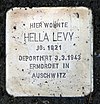
|
Hella Levy | On the ridge 43 | location | March 3, 2015 | Hella Levy was born on February 6, 1921 in Berlin as the youngest daughter of the agent Max Levy and his wife Erna nee Adam. She had an older sister, Ellen. The family lived in a house in Dahlem, Auf Grad 43, that belonged to their mother. Her sister Ellen became a kindergarten teacher and passed the state examination. What training Hella received is unknown. In 1939 her mother had to sell the house and the family moved to the house at Stuttgarter Platz 6. From there, all four family members were deported to Auschwitz on March 3, 1943 as part of the factory campaign. No date of death is known. |

|
Max Levy | On the ridge 43 | location | March 3, 2015 | Max Levy was born on December 1, 1883 in Leipzig as the son of the businessman Isidor Levy and his wife Emma Henriette, nee Wertheimer. When he married Erna Margarete Adam in Berlin in 1914, he was already living in Berlin and described himself as an agent. The daughters were born: Ellen on November 2, 1919 and Hella on February 6, 1921. In 1923 Erna Levy bought the property on Auf dem Grat 43 and had a house built for the family, where she has lived ever since. In 1938 his wife had to sell the house, the family moved to Stuttgarter Platz 6, from where they were deported to Auschwitz concentration camp on March 3, 1943 as part of the factory campaign. No date of death is known for any family member. |

|
Martin Meirowsky | Englerallee 6 | Apr 4, 2011 | Martin Meirowsky was born on February 25, 1870 in Danzig, the son of Philipp Meirowsky and his wife Bertha, born Sternfeld. His mother went to the registry office in Gdansk in 1888 and reported the births of their four children: 1862 Selma, 1867 Meta, 1870 Martin and 1872 Paula. For this late announcement of the births, she presented a permit from the supervisory authority. The father Philipp died before 1910 and the other family members moved to Berlin at Geisbergstrasse 40. From 1915 to 1925, the mother Bertha Meirowsky was the main tenant, afterwards Martin, who called himself a businessman, after him his sisters Selma and Meta lived there. In the early 1930s, Martin became an authorized signatory and lived at Steglitzer Opitzstrasse 5 until 1939. He is said to have been married, but was divorced again. In May 1939 he lived in the house at Englerallee 6, which was owned by Bianka Hamburger. He had to move to Sächsische Strasse 72, where he committed suicide on January 14, 1943. His sisters Selma and Meta fell victim to the Holocaust. | |

|
Ida Meyerhardt | Under the oaks 65 |
|
Dec 1, 2005 | Ida Cohn was born on April 8, 1866 in Konitz / West Prussia as the daughter of Nathan Cohn and his wife Johanna nee Davidsohn. She married the medical councilor Dr. Sally Meyerhardt, who treated skin, urinary and hair ailments. The first daughter Käthe Ulrica was born on May 29, 1897 in Friedeberg / Neumark, the second daughter, Alice, was born on February 22, 1900 in Berlin. Sally Meyerhardt and her family first settled in Münzstrasse, later in Münchener Strasse 33. Sally Meyerhardt died in 1937, after which Ida Meyerhardt moved to Nürnberger Strasse 37 together with Edith Hermann, née Rosenthal. They both had to move out, Ida Meyerhardt to the house at Unter den Eichen 65. From there she was deported to Theresienstadt on October 3, 1942, where she was murdered on November 18, 1942. Their daughter Alice had married Ernst Mendelsohn and they were deported to the Auschwitz concentration camp on March 2, 1943 together with their daughter Eva, who was born in 1929. The daughter Käthe had first married the doctor Rudolf Hellering, had been divorced in 1930 and emigrated to the USA, where she married again and died in Los Angeles in 1995. |

|
Emil Milk | Rheinbabenallee 49 | July 3, 2010 | Emil Milch was born on January 2, 1883 in Smyrna / Izmir / Ottoman Empire into a Jewish family. He had two sisters, Else born in 1881 and Adela born in 1887. Emil Milch became a textile merchant and married the non-Jewish Wilhelmine. The son Walter was born on December 10, 1915 in Athens, the daughter Ernestine followed and on November 21, 1919 the son Erich was born in Athens. In 1924 Emil Milch lived with his family at Rheinbabenallee 49 in Dahlem, and from 1925 they owned the house. In 1939 he was no longer registered there, at the 1939 census he lived with his son Walter at Regensburger Strasse 4. Emil Milch was deported from Regensburger Strasse 4 on February 2, 1945, the transport was intended for Sachsenhausen, then to Theresienstadt diverted. Emil Milch is named on the list as an accountant. There is also an index card from Theresienstadt on which Emil Milch's date of birth and death date March 20, 1945 are noted next to Emil Milch's name. It can be assumed that Emil Milch was murdered in Theresienstadt. His two sisters, Else Ritscher and Adela Neustadtl, were murdered and his three children survived. | |

|
Edith Muller | Waltraudstrasse 27 | July 3, 2010 | Edith Wertheim was born on March 18, 1898 in Berlin as the daughter of Gerson named Gustav Wertheim and his wife Henriette nee Levy. Her sisters were Wally (1897) and Lilli (1901), and her father was a successful lingerie manufacturer. In 1919 Edith married the lawyer Johannes Müller, who was born in Berlin on November 6, 1893. The daughters were born: Ellen Marion on September 26, 1920 and Inge Margot on November 7, 1927. Her husband, who later called himself Jean Paul Müller, received his doctorate and worked as a lawyer in Berlin. a. he was an advisor to the regional association of Greater Berlin of the Stahlhelm, Bund der Frontsoldaten . The family lived in Zehlendorf (now Dahlem), Waltraudstrasse 27. On August 1, 1933, the family emigrated to France and lived in Neuilly from 1933 to 1938, when Jean Paul Müller was a film producer. In 1939 they moved to Paris, 1940 to Pau and finally to Nice. In 1943 Jean Paul Müller fled to Paris and lived there underground. Edith Müller was arrested in September 1943, taken to the Drancy assembly camp and from there to Auschwitz on October 28, 1943. The date of her death is unknown. Her husband Jean Paul Müller managed to get to the USA during the occupation, where he earned his living as a bartender. The daughters survived, Ellen Marion married Pierre Haymann, moved to England, had two children and died in London in 2010. Her sister Inge Margot later called herself Huguette and married James Carlton, they lived in San Francisco. | |

|
Klara Rawack | Ihnestrasse 47 | Klara Saloschin was born on April 20, 1883 in Lissa / Posen to a Jewish family. She moved to Berlin and married Richard Rawack, who was born in Berlin on October 5, 1875. Her husband was a businessman and later became a book auditor. The couple probably had no children. At first they lived in Lothringerstrasse, then at Bozener Strasse 28 and finally at Ihnestrasse 47 in their own house. Her husband still owned a piece of land at Boddinstrasse 12. The couple had to move out after 1939 and move as sub-tenants to Bleibtreustrasse 37 to Hirschlaff. From there they were deported on the first transport from Berlin on October 18, 1941 to the Litzmannstadt ghetto. They lived there at Hohensteinstrasse 37. On April 5, 1942, Klara Rawack received permission to write an exception letter, which was her last sign of life. Her husband died on April 26, 1942 of the poor conditions in the ghetto. Klara Rawack was deported to Kulmhof on May 15, 1942 and murdered on the same day. | ||
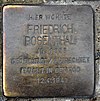
|
Friedrich Rosenthal | Englerallee 6 | Apr 4, 2011 | Friedrich Fritz Rosenthal was born on October 15, 1896 in Berlin to a Jewish family. He became a businessman and lived at Englerallee 6 in 1939. On May 8, 1940, he married Hildegard Laubhardt, who came from a Jewish family, was raised Protestant, but converted back to Judaism. That is why she was regarded by the Nazis as a " valid Jewess ". The couple received support from Quakers who were friends with Hildegard . They left Berlin on December 11, 1942 and went underground, first in Mannheim and later in Saarbrücken. On April 12, 1943, the couple was arrested by the Gestapo in Saarbrücken, Fritz Rosenthal committed suicide with potassium cyanide, Hildegard Rosenthal was transferred to Berlin and interrogated. On June 29, 1943 she was deported to Theresienstadt and on October 12, 1944 to the Auschwitz concentration camp. For her there has been a stumbling block in front of the house Im Dol 67 a since 2014, for her husband since 2011 in front of Englerallee 6. | |

|
Hildegard Rosenthal | In Dol 67a | 2014 | Hildegard Laubhardt was born on May 20, 1896 in Berlin as the daughter of the District Court Councilor Ernst Laubhardt, born Lewinsohn, and his wife Margarete, born Dammer. Her brother Rudolf was born in 1895, her sister Ilse in 1897 and Eva in 1904. The family belonged to the Protestant Church. For a long time the father was a magistrate in Bunzlau, where his children grew up. Hildegard attended the grammar school in Droyssig, Saxony-Anhalt, and probably afterwards the teachers' seminar there. Hildegard and her sister Ilse converted to Judaism and emigrated to Palestine. Hildegard returned to Germany in the 1930s and worked as a teacher in Lotte Kaliski's private Jewish school, and later in the children's and youth aliyah , where Jewish children were prepared for emigration to Palestine. On May 8, 1940, she married the Jewish businessman Friedrich (Fritz) Rosenthal and was now classified by the Nazis as a "valid Jewess" and threatened with deportation. She also had to do forced labor in a laundry. She and her husband received help from a Quaker friend from Mannheim, who supported them with money and food stamps. On December 11, 1942, Hildegard and Fritz left Berlin and went into hiding. They were hidden with various families, including the family of the Quaker friend. On April 12, 1943, they were arrested in Saarbrücken, their husband Fritz committed suicide with potassium cyanide, Hildegard was brought to Berlin and interrogated. On June 29, 1943 she was first deported to Theresienstadt and on October 12, 1942 to the Auschwitz concentration camp, where she was presumably immediately murdered. For her husband Fritz there is a stumbling block in front of the house at Englerallee 6, where he lived in 1939. | |

|
Gustav Stolper | Englerallee 25 | Nov 14, 2015 | ||

|
Toni Stolper | Englerallee 25 | Nov 14, 2015 | ||
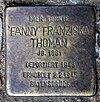
|
"Fanny" Franziska Thoman | Koserstrasse 21 | 25 Sep 2006 | ||

|
Arthur Zarden | Goßlerstrasse 21 | May 6, 2011 | ||

|
Max Zellner | Bachstelzenweg 17 | Oct 15, 2013 | Max Zellner was born on March 13, 1878 in Ostrowo / Posen as the son of the music teacher Julius Zellner and his wife Ottilie, born Laser. He first studied law in Berlin, then switched to medicine and studied in Berlin, Breslau and Freiburg im Breisgau. He received his license to practice medicine in Berlin in 1901. He worked as a general practitioner in his practice on Landsberger Strasse. In 1909 he married Regina Luise Stern, the couple adopted Stefanie Konstanze, born in 1919. The family first moved to Helmstedter Straße and in 1932 to Dahlem to Bachstelzenweg 17 into their own house. In 1938 Max Zellner's license to practice medicine was revoked, after 1939 Max and Regina Zellner had to leave their house and move to Hohenzollerndamm 184 as sub-tenants. They were arrested as part of the factory operation and deported to Auschwitz on March 12, 1943 on the 36th Osttransport. A date of death is not known. The daughter Stephanie emigrated to Palestine before 1939, married Michael Bernie Bernstein and lived with him in the USA and Canada; in the evening of her life they moved to Israel, where Stephanie died in 2012. | |

|
Regina Zellner | Bachstelzenweg 17 | Oct 15, 2013 | Regina Luise Stern was born on January 8, 1885 in Berlin as the daughter of the businessman Georg Hermann Stern and his wife Helene, née Friedländer. She married the general practitioner Max Zellner in 1909. The couple lived initially on Landsberger Strasse, later on Helmstedter Strasse. They adopted Stefanie Konstanze, who was born in 1919, and moved into their own house at Bachstelzenweg 17 in Dahlem in 1932. In 1938 Max Zellner's license to practice medicine was revoked, after 1939 Max and Regina Zellner had to leave their house and move to Hohenzollerndamm 184 as sub-tenants. They were arrested as part of the factory operation and deported to Auschwitz on March 12, 1943 on the 36th Osttransport. A date of death is not known. The daughter Stephanie emigrated to Palestine before 1939, married Michael Bernie Bernstein and lived with him in the USA and Canada; in the evening of her life they moved to Israel, where Stephanie died in 2012. | |
Web links
Commons : Stolpersteine in Berlin-Dahlem - Collection of images
Individual evidence
- ↑ bundesarchiv.de
- ↑ radiomuseum.org
- ^ Bruno Asch in the database of Stolpersteine in Berlin
- ↑ bundesarchiv.de
- ↑ statistik-des-holocaust.de
- ↑ Memorial book - detailed edition. Berlak, Leo. Evangelical Church District Teltow-Zehlendorf, accessed on February 8, 2013 .
- ^ Documents by Bernhard Einsig. (PDF; 524 kB) (No longer available online.) Evangelical Church District Teltow-Zehlendorf, October 2, 2010, archived from the original on March 9, 2016 ; Retrieved February 8, 2013 . Info: The archive link was inserted automatically and has not yet been checked. Please check the original and archive link according to the instructions and then remove this notice.
- ^ Curt Jakob Eisner in the database of Stolpersteine in Berlin
- ^ Erna Eisner in the database of Stolpersteine in Berlin
- ^ Eva Eisner in the database of Stolpersteine in Berlin
- ^ Ruth Eisner in the database of Stolpersteine in Berlin
- ^ Ludwig Anton Salomon Fulda in the database of Stolpersteine in Berlin
- ↑ bundesarchiv.de
- ↑ statistik-des-holocaust.de
- ↑ bundesarchiv.de
- ↑ statistik-des-holocaust.de
- ↑ bundesarchiv.de
- ↑ statistik-des-holocaust.de
- ↑ bundesarchiv.de
- ↑ statistik-des-holocaust.de
- ↑ stolpersteine-berlin.de
- ↑ bundesarchiv.de
- ↑ bundesarchiv.de
- ↑ statistik-des-holocaust.de
- ↑ bundesarchiv.de
- ↑ statistik-des-holocaust.de
- ↑ bundesarchiv.de
- ↑ statistik-des-holocaust.de
- ↑ bundesarchiv.de
- ↑ statistik-des-holocaust.de
- ↑ Birth certificate of the registry office Free City of Danzig No. 3993/1880
- ↑ bundesarchiv.de
- ↑ Meyerhardt Ida: Death display Theresienstadt ghetto on holocaust.cz
- ↑ bundesarchiv.de
- ↑ statistik-des-holocaust.de
- ↑ bundesarchiv.de
- ↑ crt-ii.org (PDF)
- ↑ bundesarchiv.de
- ↑ statistik-des-holocaust.de
- ↑ bundesarchiv.de
- ↑ stolpersteine-berlin.de
- ↑ bundesarchiv.de
- ↑ bundesarchiv.de
- ↑ Rebecca Schwoch (Ed.): Berlin Jewish Statutory Health Insurance Physicians and their fate under National Socialism. Hentrich & Hentrich Teetz, Berlin 2009, ISBN 978-3-941450-08-0 .
- ↑ statistik-des-holocaust.de
- ↑ bundesarchiv.de
- ↑ statistik-des-holocaust.de
